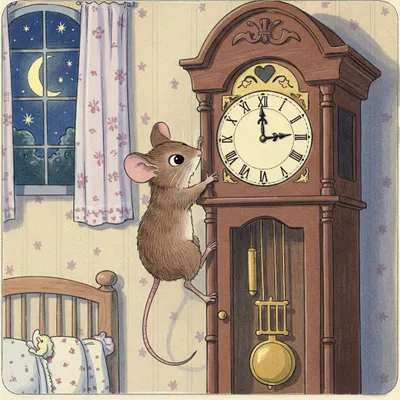Hickory Dickory Dock

Lyrics
The mouse ran up the clock
The clock struck one
The mouse ran down
Hickory dickory dock.
Hickory dickory dock
The mouse ran up the clock
The clock struck two
The mouse went "boo!"
Hickory dickory dock.
Hickory dickory dock
The mouse ran up the clock
The clock struck three
The mouse went "weeee!"
Hickory dickory dock.
Hickory dickory dock
The mouse ran up the clock
The clock struck four
The mouse went "no more!"
Hickory dickory dock.
History and Meaning
"Hickory, Dickory, Dock" first appeared in print in London in 1744, making it one of the earliest documented English nursery rhymes. Its simple narrative—a mouse climbing a clock, the clock striking one, and the mouse running down—has remained remarkably consistent for nearly three centuries, though many versions extend the rhyme through multiple hours with the mouse repeating its actions.
The nonsensical opening phrase has inspired three fascinating origin theories. One suggests it derived from ancient Cumbric counting words used by northern English shepherds - "Hevera (8), Devera (9), Dick (10)" - connecting the seemingly meaningless words to an extinct Celtic language. Another links the rhyme to the 15th-century astronomical clock in Exeter Cathedral, where rodents attracted to animal fat lubricant would climb the mechanism. Supporting this theory is a small hole cut into the door to the clock, allegedly to allow cathedral cats access to hunt mice plaguing the clockworks.
Perhaps most intriguing is the political satire theory that views the rhyme as mocking Richard "Tumbledown Dick" Cromwell, who briefly succeeded his father as Lord Protector in 1658 before quickly losing power. This interpretation sees "Hickory Dick" as Richard Cromwell himself, his mouse-like ascent and descent symbolizing his brief nine-month rule, and his timid character compared to his formidable father reflected in the mouse imagery.